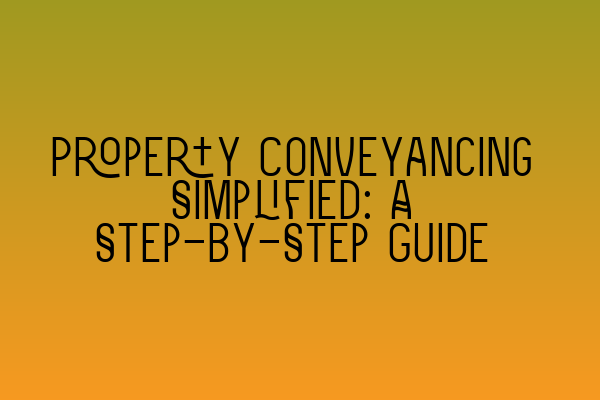Property Conveyancing Simplified: A Step-by-Step Guide
Welcome to SQE Property Law & Land Law, where we make property conveyancing easy and stress-free. Buying or selling a property can be a complex process, but with our step-by-step guide, you’ll be able to navigate through it with confidence.
Before we dive into the steps, it’s important to understand the concept of property conveyancing. Conveyancing refers to the legal process of transferring the ownership of a property from one owner to another. It involves various legal and administrative tasks that ensure the transaction is valid and binding.
Step 1: Finding a Solicitor
The first and most crucial step in the conveyancing process is finding a reputable solicitor who specializes in property law. A solicitor will act as your legal representative throughout the process, handling all the necessary paperwork and ensuring that your interests are protected.
To find a solicitor, you can ask for recommendations from friends, family, or colleagues who have recently bought or sold a property. Alternatively, you can search online directories or use the services of professional organizations, such as the Law Society, to find a qualified property solicitor.
Understanding Contractual Capacity: Rights and Limitations
Step 2: Offer and Acceptance
Once you have found a solicitor, the next step is to make an offer on the property you wish to buy. Your solicitor will help you draft an offer letter that outlines the details of your offer, such as the purchase price, desired completion date, and any special conditions.
After submitting your offer, the seller will either accept, reject, or make a counteroffer. If your offer is accepted, you can move on to the next step. If the seller rejects your offer or counters with a different price or conditions, negotiations may take place until both parties reach an agreement.
Step 3: Property Searches and Surveys
Before proceeding with the purchase, it’s essential to conduct property searches and surveys to identify any potential issues or liabilities. These searches and surveys provide vital information about the property’s legal and physical condition, such as planning permissions, boundary disputes, or structural problems.
Your solicitor will handle these searches on your behalf, ensuring that you are fully informed about the property’s status before making a final decision. It’s crucial to carefully review the results of these searches, as they can affect the value and desirability of the property.
Step 4: Exchange of Contracts
Once you are satisfied with the property’s condition and have secured financing, it’s time to exchange contracts. This is a legally binding step that confirms the sale or purchase of the property.
At this stage, your solicitor will review the draft contract provided by the seller’s solicitor and negotiate any necessary amendments or clarifications. Once both parties are satisfied with the contract terms, you and the seller will sign copies of the contract, and the exchange will take place.
Interactive SQE Mock Tests for Contract Law: Test Your Knowledge
Step 5: Completion
The completion date is the day when the property officially changes ownership. On this day, your solicitor will transfer the purchase funds to the seller’s solicitor, and you will receive the keys to your new property.
Before completion, your solicitor will carry out final checks to ensure that all necessary documents and payments are in order. These checks include verifying that the seller’s title is clear of any outstanding mortgages or liens and calculating the final amount to be paid, including taxes and fees.
Step 6: Post-Completion and Registration
After completion, your solicitor will handle the post-completion tasks, such as paying the Stamp Duty Land Tax (SDLT) and registering your ownership with the Land Registry. Registering the property under your name is crucial to establish your legal ownership and to protect your interests.
Once the registration is complete, you will receive an official confirmation from the Land Registry, indicating that you are the legal owner of the property.
Conclusion
Congratulations! You have successfully completed the property conveyancing process. While these steps may seem overwhelming at first, having a qualified solicitor by your side can make all the difference.
If you are ready to start your property conveyancing journey, our team at SQE Property Law & Land Law is here to assist you every step of the way. Contact us today to schedule a consultation and let us simplify the conveyancing process for you.
Join Our SQE Contract Law Webinars: Expert Insights and Guidance
SQE Prep: Mastering the Essentials of Contract Law
Contractual Capacity: Understanding Legal Competence in Contracting Parties
